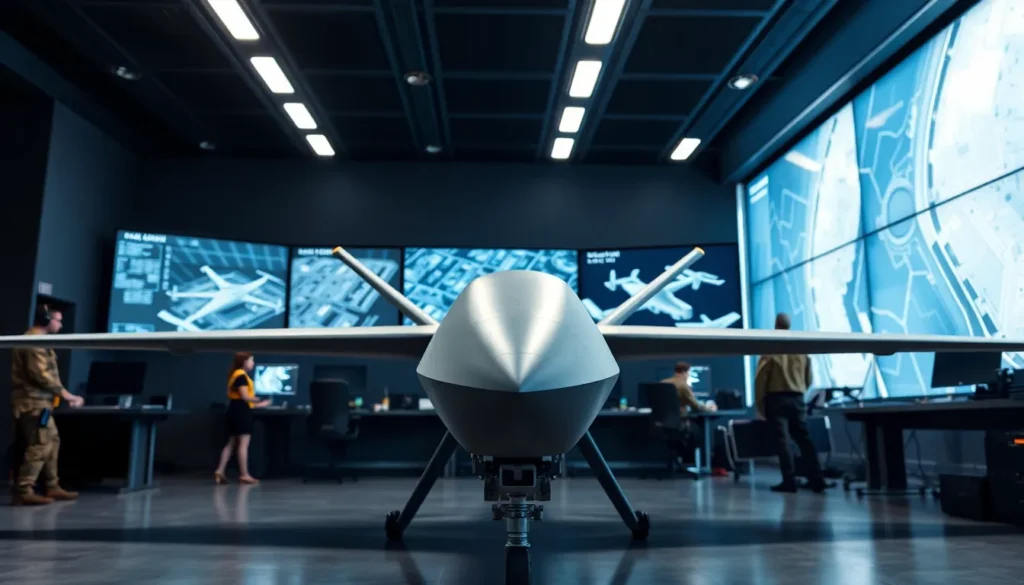In a land where the Great Wall meets cutting-edge technology, drones have taken to the skies like a flock of high-tech birds. China’s drone industry isn’t just buzzing; it’s soaring to new heights, transforming everything from agriculture to urban planning. With a mix of innovation and a dash of that classic Chinese entrepreneurial spirit, these flying gadgets are reshaping the landscape in ways that leave even the most seasoned tech enthusiasts scratching their heads in awe.
But it’s not all serious business. Imagine a drone delivering your takeout faster than you can say “Kung Pao Chicken.” As China leads the charge in drone development, it’s hard not to chuckle at the thought of future delivery drones zipping around, dodging traffic like a pro. Get ready to explore how these aerial marvels are revolutionizing industries and making life a little more exciting, one flight at a time.
Table of Contents
ToggleOverview of Drones in China
China’s drone industry shows remarkable growth, positioning the nation as a global leader. Several sectors benefit from innovations in drone technology, specifically agriculture, construction, and logistics. Agricultural experts utilize drones for tasks like crop monitoring and pesticide spraying, improving efficiency and yield.
Additionally, urban planners leverage drones to create accurate 3D maps and assess infrastructure needs. A significant reliance on drone technology accelerates construction timelines, allowing for quicker project completions. Logistics firms employ drones for efficient last-mile delivery services, enhancing consumer satisfaction.
Surveys indicate that the market size for drones in China reached approximately $10 billion in 2022. Projections suggest this figure may double by 2025, reflecting ongoing demand. Moreover, China’s investment in drone research and development exceeds $1.5 billion annually.
Regulatory frameworks evolve alongside industry growth. The Civil Aviation Administration of China enforces strict guidelines to ensure safety and operational efficiency. Operators must adhere to regulations, including licensing and flight path approval.
Innovators contribute continuously to this booming market. Companies like DJI lead in commercial drone manufacturing, typically launching cutting-edge models each year. The presence of numerous startups fosters competitive development, encouraging advances in artificial intelligence and autonomous flight systems.
Enthusiastic consumer markets embrace recreational drones, fostering a culture of innovation. Trough expert communities and hobbyist groups, knowledge-sharing amplifies interest, further driving demand. Overall, the dynamic landscape of drones in China creates widespread opportunities for economic growth and societal improvements.
Types of Drones Used in China
Drones in China encompass various categories, each serving distinct purposes across industries. Key types include consumer drones and commercial drones.
Consumer Drones
Consumer drones enjoy widespread popularity in China, mainly due to their accessibility and high-quality features. Enthusiasts utilize these drones for aerial photography, videography, and recreational flying. Major brands like DJI lead this market, offering models that cater to various skill levels. These devices often include advanced functionalities, such as obstacle avoidance and GPS capabilities. The demand for consumer drones continues to rise, supported by a growing community of hobbyists and influencers who showcase their experiences online. Such engagement drives innovation, attracting new users to explore the world of drone flight.
Commercial Drones
Commercial drones play a vital role in several sectors within China, contributing to enhanced operational efficiency and data collection. Industry applications range from agriculture monitoring to construction site surveying. In agriculture, farmers deploy drones for crop assessment and pesticide application, significantly improving yield management. Meanwhile, construction firms utilize drones for site inspections and progress tracking, leading to better project management. Logistics companies engage drones to streamline last-mile delivery processes, thus promoting enhanced customer satisfaction. The commercial drone market is rapidly expanding, driven by technological advancements and increasing investments. This trend is evident as businesses leverage drones to improve productivity and achieve competitive advantages.
Regulatory Environment
China’s regulatory environment for drones evolves rapidly to address the industry’s growth and ensure safety. Government policies shape the landscape of drone operations and applications across various sectors.
Government Policies
Policies in China foster innovation and economic development in the drone industry. The Civil Aviation Administration of China (CAAC) implements comprehensive regulations that guide manufacturers and operators. Registration is mandatory for drones weighing over 250 grams. Local governments often establish additional guidelines to suit regional needs. Investments in technology and infrastructure support this sector’s expansion. The promotion of research and development also figures prominently in national policies, driving companies to innovate and maintain competitiveness.
Safety Regulations
Safety regulations play a crucial role in promoting responsible drone use in China. Operators must adhere to altitude restrictions, typically capping flights below 120 meters in populated areas. The implementation of no-fly zones around airports and sensitive sites ensures public safety. Regular maintenance and pilot training are essential requirements. Compliance with real-time air traffic monitoring systems enhances operational safety. Drones equipped with fail-safe features further mitigate risks during flights. These safety measures help maintain trust in drone technology while allowing for continued growth.
Applications of Drones in China
Drones in China have transformed numerous sectors, showcasing their versatility and innovative applications.
Agricultural Uses
Agricultural practices benefit immensely from drones. Farmers use drones for crop monitoring, allowing for early identification of diseases and nutrient deficiencies. Precision pesticide spraying reduces chemical use, promoting environmental sustainability. In 2021, approximately 70% of China’s smart agriculture initiatives incorporated drone technology. Detailed aerial imagery from drones enables farmers to make informed decisions about irrigation and fertilization. This data-driven approach enhances yields, demonstrating that agriculture in China increasingly relies on drone technology.
Surveillance and Security
Drones enhance surveillance and security measures significantly. They’re deployed in urban areas to monitor public spaces, ensuring safety and order. With over 7,000 drones used by law enforcement as of 2022, authorities can respond to incidents quickly. Surveillance drones equipped with high-resolution cameras capture real-time footage, assisting in criminal investigations. In addition, businesses utilize drones for security oversight of large facilities, preventing theft and unauthorized access. This innovative use of drone technology efficiently addresses safety concerns in rapidly urbanizing environments across China.
Impact on Economy and Industry
Drones significantly shape the economy and various industries in China. The drone market reached $10 billion in 2022, indicating strong growth. By 2025, projections suggest this figure may double, reflecting a rapidly expanding landscape. Companies such as DJI lead commercial manufacturing, showcasing China’s prowess in innovation and production.
Agriculture utilizes drones extensively, allowing precise crop monitoring and targeted pesticide application. Approximately 70% of smart agriculture initiatives in China incorporate drones. Enhanced crop yields result from data-driven decisions enabled by drone technology. In construction, drones conduct site inspections, streamlining processes and increasing operational efficiency.
Logistics firms find drones crucial for last-mile delivery. These unmanned aerial vehicles enhance customer satisfaction through efficient service. Various industries, including retail and healthcare, also benefit from improved delivery operations.
Regulatory frameworks continue evolving under the guidance of the Civil Aviation Administration of China (CAAC). As safety measures advance, innovations can flourish alongside regulations. Mandatory registration for drones over 250 grams and localized guidelines ensure safety and operational consistency.
Drone implementation in security bolsters public safety across urban areas. Over 7,000 drones assist law enforcement in surveillance tasks, capturing real-time footage for investigations. These measures address safety concerns relevant to rapidly urbanizing locations.
Investments in drone research exceed $1.5 billion annually, emphasizing the government’s commitment to innovation. The growing startup ecosystem fosters initiatives in artificial intelligence and autonomous flight systems. Together, these factors drive China’s drone industry and create economic opportunities.
Challenges and Concerns
Drones in China face several significant challenges and concerns, ranging from privacy to technological limitations.
Privacy Issues
Privacy remains a key concern in the widespread use of drones. The ability of drones to capture high-resolution images raises questions about surveillance and individual rights. In urban areas, over 7,000 drones assist law enforcement, leading to potential misuse of data. Citizens express worries regarding constant monitoring and the erosion of personal privacy, creating tension between security and civil liberties. Regulatory frameworks aim to address these issues, but concerns persist among the public. Ensuring that drone operations comply with established privacy standards is essential for maintaining public trust.
Technological Limitations
Technological limitations also hinder the full potential of drones in China. Battery life restricts flight duration, often capping operations to specific time frames. Current systems may face challenges with signal loss in densely populated areas, affecting navigation and control. Moreover, adverse weather conditions can significantly impair drone performance, limiting operational consistency. Data processing capabilities, while improving, still require advancements for efficient analysis and management. Companies are actively researching solutions, but technological barriers remain a significant concern in the industry.
China’s drone industry is on a remarkable trajectory that’s reshaping multiple sectors and enhancing everyday life. With significant investments in research and development and a growing market, the potential for innovation remains vast. As companies like DJI lead the way in commercial manufacturing, the startup ecosystem continues to thrive, pushing boundaries in artificial intelligence and autonomous systems.
While challenges such as privacy concerns and technological limitations persist, ongoing regulatory efforts aim to address these issues. The future looks promising as drones become integral to agriculture, logistics, and security. By embracing this technology responsibly, China is poised to harness the full benefits of drones, paving the way for a more efficient and connected society.





